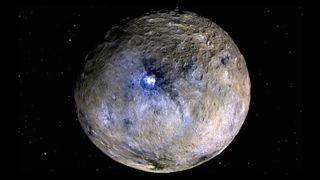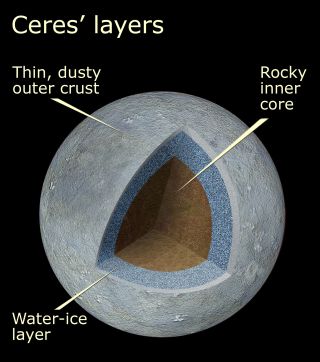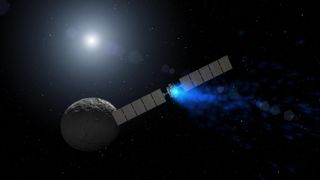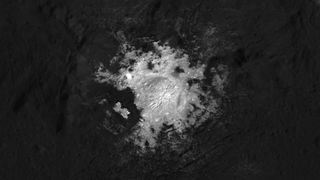Ceres: The closest dwarf planet to Earth
There's more to the dwarf planet Ceres than meets the eye. It contains a layer of salty water deep underground that can occasionally reach the surface.

Ceres is the closest dwarf planet to Earth and the largest object in the main asteroid belt between Mars and Jupiter.
Since its discovery in 1801, Ceres has had multiple identities. First, it was thought to be a planet. Then, when it became apparent that it was too small, it was reclassified as an asteroid — the first to be discovered. In 2006, Ceres was named a dwarf planet in response to the discovery of another object, Eris, that called into question how we define planets and smaller objects such as asteroids and Kuiper Belt objects.
Whatever we call it, Ceres is a ball of rock and ice with a diameter of 592 miles (953 kilometers). It is the largest object orbiting the sun in the asteroid belt between Mars and Jupiter.
Related: What is a dwarf planet?
Ceres FAQs
Is Ceres bigger than the moon?
No, Ceres is much smaller than the moon. Ceres is 592 miles (953 km) across, whereas the moon's diameter is 2,159 miles (3,475 km).
Is Ceres bigger than Pluto?
Ceres is much smaller than Pluto, which has a diameter of 1,473 miles (2,370 km).
Is Ceres colder than Pluto?
Although Ceres is cold, with daytime temperatures between minus 136 and minus 28 F (minus 33 to minus 93 C), it is still warmer than Pluto, which dips to minus 387 F (minus 232 C). This is because Ceres is much closer to the sun: 257 million miles (413 million km), on average, compared with 3.7 billion miles (5.9 billion km) for Pluto.
Who discovered Ceres?
In the late 18th century, astronomers became convinced that there was another planet between Mars and Jupiter. They deduced this based on the Titius-Bode law, named after 18th-century German astronomers Johann Daniel Titius and Johann Elert Bode, which describes an apparent pattern in the spacing of the orbits of the solar system planets. It predicted that there should be a planet in the wide gap between Mars and Jupiter.
So a group of European astronomers, calling themselves the "celestial police," set about finding this planet. But they were beaten by Italian astronomer Giuseppe Piazzi, who was not initially a member of their group when he discovered Ceres. It was thought that the problem had been solved.
But soon enough, more objects were discovered between Mars and Jupiter: Pallas was spotted in 1802, Juno in 1804 and Vesta in 1807. They couldn't all be planets. Indeed, they seemed too small; unlike Mars and Jupiter, they were unresolvable in a telescope. Instead, they represented a new class of objects: asteroids.
In the centuries since, over a million asteroids have been discovered in this region, called the main asteroid belt. Ceres is the largest of them, by far. The next largest, Vesta, is 330 miles (530 km) across.
What is Ceres named after?
Back in the 18th and 19th centuries, astronomers often wanted to name the objects they discovered after their patrons. For example, William Herschel initially tried to name Uranus "Georgium Sidus" after King George III. However, astronomers outside the United Kingdom frowned upon that name.
Similarly, when Piazzi discovered Ceres, he wanted to name it "Ceres Ferdinandea," after King Ferdinand of Sicily, who had founded the observatory in Palermo from which Piazzi discovered Ceres. The reference to royalty was dropped, but the name Ceres, the Roman goddess of agriculture and fertility, remained.
Where is Ceres?
Ceres orbits the sun between the orbits of Mars and Jupiter. Its elliptical orbit puts the dwarf planet between 2.55 astronomical units (AU), or 237 million (381 million km), from the sun at its closest point (perihelion) and 2.98 AU, or 277 million miles (446 million km) from the sun at its farthest point (aphelion).
Ceres takes 4.6 Earth years, or 1,682 Earth days, to orbit the sun, according to NASA. Days on Ceres are much shorter than on Earth, with Ceres spinning on its axis once every nine hours.
What is it like on Ceres?
Living on Ceres would not be fun. The dwarf planet has no atmosphere, so you'd need to wear a spacesuit. This would not only provide you with air to breathe but also protect you from the freezing temperatures, which, on Ceres' day side, range from minus 136 to minus 28 degrees Fahrenheit (minus 93 to 33 degrees Celsius). Nighttime temperatures are around 225 F (minus 143 C).
On the plus side, you'd feel like you'd lost a lot of weight. The gravity is only 0.2 to 0.3 meters per square second or about 3% of that on Earth. That means that if you weighed 150 pounds (68 kilograms) on Earth, you'd feel like you weighed 4.5 pounds (2.04 kg) on Ceres.

How does Ceres compare to the other dwarf planets?
Ceres is the closest dwarf planet to Earth. All of the other dwarf planets in the solar system are very far away, in the Kuiper Belt beyond Neptune.
Ceres has some similarities with the other dwarf planets, such as Pluto and Eris. It is rubble left over from the formation of the solar system — a protoplanet that was stillborn and never grew any further.
However, Ceres differs in its composition: Ceres is mostly rocky, whereas Pluto and its neighbors are mostly icy.
Ceres does have some ice, however. Its overall density is only about 2 to 2.3 grams per cubic centimeter, which is too low to be all rock. This implies that a quarter of Ceres is made of ice, mixed in with the surface regolith and in layers beneath the surface.
Dawn spacecraft's visit to Ceres

In 2015, NASA's Dawn spacecraft, having already visited Vesta, traveled to Ceres. As Dawn approached Ceres, it imaged a bright spot on the surface, which, as Dawn neared, resolved into bright patches, called Cerealia Facula and Vinalia Faculae. Upon closer inspection, hundreds of bright patches have been observed on Ceres. Planetary scientists were puzzled by this. Could the bright areas be patches of exposed ice?
When Dawn arrived in orbit around Ceres and took high-resolution images of the bright spots, the largest area of white deposits was found within a 57-mile-wide (92 km) crater called Occator. These spots are not ice, though. Instead, they are mostly sodium carbonate left behind by briny water that gurgled up to the surface and sublimated, leaving behind sodium carbonate deposits.
How can water exist on such a large, airless object? Data from the Dawn mission suggests that the briny water originates from a reservoir 25 miles (40 km) beneath the cratered surface and that the sodium carbonate was first left behind on the surface within the past 9 million years as cryovolcanism brought slushy liquid to the surface. The process seems to be ongoing — Dawn detected water still in the sodium carbonate sediments, and since water should sublimate quickly when exposed to the vacuum of space, the water must be being replenished for Dawn to have detected it.
The extent of this underground water is uncertain. If we could slice Ceres in half, we would find that it is "differentiated." This means that when it formed, its interior was warm enough to separate into different layers, with the densest material sinking to the core. Ceres' core is, therefore, formed from rocks and clays. Above this large core is the briny water-ice layer, which extends 60 miles (100 km) below the surface), and possibly even deeper. The external layer is a 25-mile-thick crust of regolith, salty minerals and ice.

Is there life on Ceres?
The possibility of life on Ceres seems unlikely, given the high salt levels and low temperature. Because of the presence of water, however, it cannot be ruled out.
Alternatively, life may have existed there in the past, when Ceres was warmer. Planetary scientists have called for Ceres to be treated as an ocean world and placed on a par with the likes of Jupiter's moon Europa and Saturn's moon Enceladus as having interest for astrobiologists. To that end, the 2023 Planetary Science Decadal Survey has suggested that a sample-return mission from Ceres should be a top priority. If anything does live on Ceres, it would be very simple microbes, according to NASA.
Ceres expert Q&A
We spoke with Andreas Nathues, a scientist at the Max Planck Institute for Solar System Research in Germany, about the curious nature of Ceres' bright patches and the inference that they come from a water layer deep beneath the dwarf planet's surface.
Andreas Nathues is a scientist at the Max Planck Institute for Solar System Research in Germany. His expertise is the development of scientific instrumentation (VIS-NIR spectrometers/cameras) for interplanetary space probes as well as data analyses of these instruments.
Did the impact that formed Occator crater on Ceres 22 million years ago drive the cryovolcanism that resulted in the bright patches on the surface?
The impact initially triggered the activity by pressure relief and starting the process of forming conduits through the crust for the brines to travel. [But the cryovolcanic] activity is likely driven by the exsolution of gases; obviously it took many millions of years until the brines made it up to the surface via cracks/fractures that opened late. Likely the activity will continue; it's unlikely to assume that it stopped about 1 million years ago and will not continue.
Did the layer of underground briny water form at the same time as Ceres itself?
No, this layer formed during the partial differentiation process of Ceres. At the end of its early evolution, Ceres had a large, icy shell that was [mostly] lost to space due to sublimation. The water of this shell froze from top to bottom, and an ocean at depth is all that's left.
What do protoplanets like Ceres that went on to form worlds like Earth tell us? Could they have brought water or life to Earth?
These protoplanets are too big to deliver organics; organics would get destroyed during the impact process between such a large body and Earth. However, objects of a few hundred meters to kilometers in size could have brought water to Earth. Whether these could have also transferred organics is unclear, but the impact speeds were probably too high to not destroy them.
Additional resources
This infographic from NASA's Jet Propulsion Laboratory shows the five official dwarf planets: Ceres, Pluto, Eris, Makemake and Haumea. You can also find out more about them from this article from The Planetary Society.
NASA's Dawn mission is the only spacecraft that has visited Ceres. You can learn more about the Dawn mission on NASA's Dawn mission website.
Bibliography
'Pluto and the Developing Landscape of Our Solar System', IAU, https://www.iau.org/public/themes/pluto/
'Ceres Facts', NASA, https://science.nasa.gov/dwarf-planets/ceres/facts/
Hoskin, Michael; 'Bode's Law and the Discovery of Ceres', Physics of Solar and Stellar Coronae: G. S. Vaiana Memorial Symposium, https://link.springer.com/chapter/10.1007/978-94-011-1964-1_3
'The Discovery of Asteroids', European Space Agency, 2019, https://sci.esa.int/web/astrophysics/-/29802-asteroids
Forbes, Eric G.; 'Gauss and the Discovery of Ceres', Journal for the History of Astronomy, Vol. 2, p.195, 1971, https://adsabs.harvard.edu/full/1971JHA.....2..195F
'Study reveals details of "golf ball asteroid, MIT News, 2020,
https://news.mit.edu/2020/pallas-golf-ball-asteroid-0210
Cunningham, Clifford J.; 'The discovery of Juno and its effect on Olbers' asteroid explosion hypothesis', Journal of Astronomical History and Heritage, 7, No. 2, p.116–117, 2004, https://ui.adsabs.harvard.edu/abs/2004JAHH....7..116C/abstract
Cunningham, Clifford J.; 'The Discovery of Vesta', Investigating the Origin of the Asteroids and Early Findings on Vesta, Springer, 2017, https://link.springer.com/chapter/10.1007/978-3-319-58118-7_4
'Asteroids, Comets and Meteors', NASA, https://science.nasa.gov/asteroids-comets-meteors/
'Vesta Sizes Up', NASA, 2023, https://science.nasa.gov/resource/vesta-sizes-up/
Williams, David R,; 'Moon Fact Sheet', NASA NSSDC, 2024, https://nssdc.gsfc.nasa.gov/planetary/factsheet/moonfact.html
Zolotov, M.; 'Is Ceres Differentiated?', American Geophysical Union, 2008, https://ui.adsabs.harvard.edu/abs/2008AGUFM.P51C1424Z/abstract
'New Clues to Ceres' Bright Spots and Origins', NASA, 2018, https://solarsystem.nasa.gov/news/593/new-clues-to-ceres-bright-spots-and-origins/
'Close-up of Occator Crater', NASA–JPL, 2020 https://www.jpl.nasa.gov/images/pia24022-close-up-of-occator-crater
'Mystery Solved: Bright Areas on Ceres Come From Salty Water Below', NASA–JPL, 2020, https://www.nasa.gov/centers-and-facilities/jpl/mystery-solved-bright-areas-on-ceres-come-from-salty-water-below/
Patel, Neel V.; 'The dwarf planet Ceres might be home to an underground ocean of water', MIT Technology Review, 2020, https://www.technologyreview.com/2020/08/11/1006447/ceres-largest-asteroid-dwarf-planet-underground-ocean-salty-water/
Ermakov, Anton I., et al; 'Surface Roughness and Gravitational Slope Distributions of Vesta and Ceres', JGR Planets, 124, issue 1, 2018, https://agupubs.onlinelibrary.wiley.com/doi/full/10.1029/2018JE005813
Stein, N. T. et al; 'The formation and evolution of bright spots on Ceres', Icarus, 320, p. 188–201, 2019, https://www.sciencedirect.com/science/article/pii/S0019103517303627
Schenk, P. et al; 'Impact heat driven volatile redistribution at Occator crater on Ceres as a comparative planetary process', Nature Communications, 11, 3679, 2020, https://www.nature.com/articles/s41467-020-17184-7
Nathues, a. et al; 'Recent cryovolcanic activity at Occator crater on Ceres', Nature Astronomy, 4, 794–801, 2020, https://www.nature.com/articles/s41550-020-1146-8
'Ceres' Internal Structure (Artist's Concept)', NASA–JPL, 2018, https://www.jpl.nasa.gov/images/pia22660-ceres-internal-structure-artists-concept
Neveu, Marc; 'Ceres, a window into how planets could harbor life', Physics Today, 76, 12, 54–55 (2023), https://pubs.aip.org/physicstoday/article/76/12/54/2923599/Ceres-a-window-into-how-planets-could-harbor
Castillo-Rogez, Julie; 'Future exploration of Ceres as an ocean world', Nature Astronomy, 4, 732–734, 2020, https://www.nature.com/articles/s41550-020-1181-5
Origins, Worlds and Life: A Decadal Strategy for Planetary Science and Astrobiology 2023–2032, https://nap.nationalacademies.org/catalog/26522/origins-worlds-and-life-a-decadal-strategy-for-planetary-science
Carter, Jamie; 'Why this Ceres mission could change the search for alien life', The Planetary Society, 2022, https://www.planetary.org/articles/ceres-sample-return-mission-alien-life
'Pluto Facts', NASA, https://science.nasa.gov/dwarf-planets/pluto/facts/
Join our Space Forums to keep talking space on the latest missions, night sky and more! And if you have a news tip, correction or comment, let us know at: community@space.com.
Get the Space.com Newsletter
Breaking space news, the latest updates on rocket launches, skywatching events and more!

Keith Cooper is a freelance science journalist and editor in the United Kingdom, and has a degree in physics and astrophysics from the University of Manchester. He's the author of "The Contact Paradox: Challenging Our Assumptions in the Search for Extraterrestrial Intelligence" (Bloomsbury Sigma, 2020) and has written articles on astronomy, space, physics and astrobiology for a multitude of magazines and websites.
